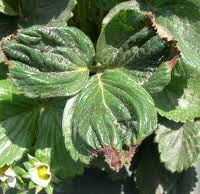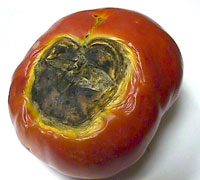How to Combat Calcium Deficiency and Improve Your Harvest
How’s your garden coming along? Many gardeners aren’t familiar with the significant role calcium plays during the fast growing season, and your plants are suffering from a deficiency, you may be disappointed in the quality of what’s growing in your garden. But fear not! It is not too late to improve your harvest with a little investigation and extra care.
Recognizing the Symptoms of Calcium Deficiency
After touring your garden to check on its progress, you may notice some of your plants are slow to reach maturity, while others may have curling, misshapen leaves that are discolored with brown spots or have leaf tip burn. (See below.)

On fruits and flowers, rot of any kind may indicate a calcium deficiency. Blossom-end rot is noted by a soft, rotting fruit tissue in plants like tomatoes, peppers, and melons. Spotting symptoms early on can help save your plants from going bad. (See below.)

Why Do Plants Need Calcium?
Calcium is essential in the process of forming new cell walls and giving stability to existing cell structures. It is critical in plant cell division and is regarded as one of the most necessary plant elements. Calcium also neutralizes organic acids in plants, enabling nutrients and water to enter more freely. Without proper levels of calcium, the shelf life of fruits and vegetables can be reduced significantly.
Using Liquid Lime to Improve Calcium Deficiencies
Lime is essentially calcium, and adding lime to your soil and plants is the best calcium booster you can give them. Our product is derived from a non-toxic, food-grade source of calcium that is often used in nutritional supplements, making it safe to use directly on fruits and vegetables. It is sugar-chelated, meaning it is bound with sugars into a form that makes it immediately available for absorption. (We do not use EDTA for chelation in any of our products.) We have also added 6% Nitrogen to speed up absorption and provide extra plant nutrition.
Foliar Feeding with Liquid Lime
Because of its limited movement in the plant, adding calcium during critical development stages such as fruiting can vastly improve fruit quality, quantity, and overall plant health. Our Liquid Lime (also called Liquid Calcium) formula can be sprayed on calcium-deficient plants for foliar absorption (through the leaves), which is the fastest and most efficient way to improve calcium levels in vegetable, fruit and flower gardens. By spraying Liquid Lime foliarly, or using drip irrigation, the nutrients are immediately available for plant uptake.
To apply, mist both the tops and bottoms of leaves to the point of runoff with a mix of 2 oz Liquid Lime per gallon of water (1/2 oz per quart). Using a fine mist sprayer, apply early in the morning or after sundown for best results.
Now, how many tomato sandwiches are too many? Enjoy your harvest!


